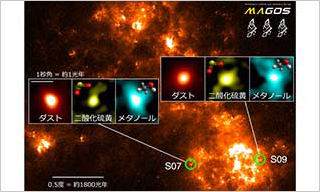Wednesday, May 10, 2023
research results
A joint international research team consisting of Takashi Shimonishi, Associate Professor, Faculty of Science, Tokyo Institute of Technology, Kei Tanaka, Assistant Professor, Tokyo Institute of Technology, Yichun Chang, University of Virginia, and Kenji Furuya, Designated Assistant Professor, NAOJ.Note 1Using , we detected for the first time in the world a molecular cloud surrounding a newborn star called a “hot core” in the Small Magellanic Cloud, a dwarf galaxy about 190,000 light-years from Earth. This achievement brought about a new development in the study of the diversity of the chemical evolution of stellar and planetary materials throughout the history of the universe.
Elements heavier than helium (carbon, nitrogen, oxygen, etc.) are made over a long period of time by nuclear fusion reactions inside stars, so they were almost non-existent when the universe was just born. There are still many mysteries about star formation and the chemical evolution of matter in such an environment with so few heavy elements. The Small Magellanic Cloud contains few heavy elements and is similar to the environment that existed about 10 billion years ago.
Discovered in this study, the ‘hot core of the Small Magellanic Cloud’ contains more complex organic molecules than hot cores in normal environments.Note 2They were much less, and there was a big difference in their distribution. These differences provide important clues that point to the diversity of material evolution and star formation processes in the early universe, where heavy elements were scarce.
The results of this research were published in The Astrophysical Journal Letters on April 4, 2023. It is also highlighted in AAS Nova, which presents outstanding research from journals (First detection of hot molecular cloud nuclei in the Small Magellanic Cloud)。
fig. The locations of two hot centers (object names: S07 and S09) have been detected in the Small Magellanic Cloud (green circles). Images of dust (interstellar dust), sulfur dioxide, and the radioactive distributions of methanol are shown for each object observed by ALMA. In the background is an infrared image of the Small Magellanic Cloud (160-micron image from the Herschel Telescope).
Score result of this search
- Discovery of a chemically rich molecular cloud surrounding a newborn star in a dwarf galaxy/Small Magellanic Cloud for the first time in the world
- The detected object contains a much smaller amount of complex organic molecules than similar objects in the Milky Way.
- The environment of the Small Magellanic Cloud is similar to that of the universe about 10 billion years ago, and the results of this study provide important clues for exploring the diversity of materials of stars and planets in the distant universe.
[قائمة المصطلحات]
Note 1. ALMA
ALMA (officially, Atacama Large Millimeter / submillimeter Array, ALMA) is a radio telescope built at an altitude of 5,000 meters in the Atacama Desert in northern Chile, South America. It is a giant interferometer-type telescope that combines 66 parabolic antennas and has the world’s highest performance in terms of resolution and sensitivity in the millimeter and submillimeter wave regions. ALMA is an international joint venture created and operated by East Asia represented by the National Astronomical Observatory of Japan, the North American Association represented by the National Radio Astronomical Observatory of the United States, Europe represented by the European Southern Observatory, and the Republic of Chile.
Note 2. Complex organic molecules
In astronomy, organic molecules made up of six or more atoms, such as methanol, are called “complex organic molecules.”
Search details
First Detection of a Hot Core in the Small Magellanic Cloud – Approaching the Chemical Evolution of Matter in the Distant Universe – (PDF: 0.5MB)
Paper information
[مجلة منشورة]Astrophysical Journal Letters[عنوان الورقة]Detection of hot molecular nuclei in the Small Magellanic Cloud
[المؤلف]Takashi Shimonishi, Kee E Tanaka, Yishin Chang, Kenji Furuya
【doi】10.3847/2041-8213/ac031
Inquiries regarding this topic
Public relations office
Email [email protected]
Read more news

“Travel maven. Beer expert. Subtly charming alcohol fan. Internet junkie. Avid bacon scholar.”





More Stories
【5つ】ホームビデオをiPhoneからパソコンへ転送する方法 | iMobie Inc.のプレスリリース
Hololabo Nishimatsu Construction Company Uses XR Technology to Develop Drone Support and 3D Model Superimposition Technology on Aerial Footage – IoT News
PlayMining, the company that issues DEAPcoin (DEP), announces a collaboration event between the famous manga “Silent Mobius” and “JobTribes”! | Digital Entertainment Asset Pte.Ltd Press Release